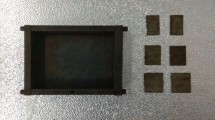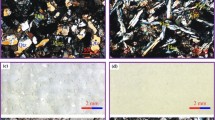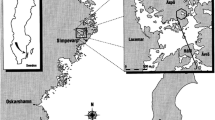Summary
Influence of Microstructure on Fracture Propagation in Rock
This paper describes the results of research to correlate the fracture resistance with microstructural features of Salem limestone and Berea sandstone. Tests were conducted on wedge-loaded double-cantilever-beam specimens containing machined slots as crack starters. The fracture resistance of Salem limestone measured in terms ofR, the energy dissipated per unit area of projected surface, was found to increase in the initial stage of crack extension but finally reached a constant value which was strongly dependent on crack orientation with respect to the bedding plane. For this limestoneR ranges from about 50 joules/m2 to 230 joules/m2 (1 joule/m2 = 104 erg/cm2). The sandstone which is a more compliant rock exhibited similar fracture behavior while theR values ranged from 465 joules/m2 to 1580 joules/m2. In addition, tests in liquid nitrogen which were aimed at eliminating plastic deformation in the rocks during fracture showed little difference inR for the limestone but a substantial reduction inR for the sandstone which, in the latter case, may be caused by differential thermal expansion between the quartz grains and the calcite cement. Acoustic emissions were detected in both rocks at very early stages in the tests indicating the occurrence of microcracking near the initial slot tip at low loads. The mode of fracture and the fracture path in both materials were identified by fractography over a broad range of magnifications. The evidence gained from this work strongly points to the existence of an extensive array of microcracks produced in a region surrounding the main crack tip and which advances with it. The energy dissipated in fracturing of rock is associated with the creation of the large amount of surface area contained in this microcrack array. This picture provides a self-consistent explanation for the puzzling discrepancy between the measured tensile strength of rocks and the strengths predicted from measuredR values.
Zusammenfassung
Der Einfluβ der Mikrostruktur auf die Bruchausbreitung im Fels
Die Verfasser beschreiben die Meßergebnisse einer Untersuchung, deren Zweck es war, die Beziehung zwischen der Bruchfestigkeit und gewissen Merkmalen des Gefüges im Salem-Kalkstein und Berea-Sandstein zu zeigen. Für diese Versuche wurden keilbeladene Doppelkragträgerproben verwendet, welche Kerben zur Förderung der Rißbildung erhielten. Es zeigte sich, daß die Bruchfestigkeit des Salem-Kalksteines, die imR Einheiten gemessen wurde (das ist der Energieverbrauch pro Projektions-flächeneinheit), während des Anfangsstadiums der Rißbildung zunahm, zuletzt aber eine konstante Größe erreichte, die eindeutig durch die Rißorientierung zur Schichtung bestimmt war. Beim Kalkstein schwanktR zwischen etwa 50 Joulen/m2 und 230 Joulen/m2. Der Sandstein, ein weicheres und nachgiebigeres Gestein, zeigte eine ähnliche Rißbildungsweise; dieR-Werte jedoch variierten zwischen 465 Joulen/m2 und 1580 Joulen/m2. Außerdem wurden Versuche in flüssigem Stickstof durchgeführt, um die während der Rißbildung in den Gesteinsproben entstehende plastische Verformung auszuschalten. FürR zeigten diese Versuche nur einen kleinen Unterschied im Falle des Kalksteins, jedoch eine wesentliche Verminderung im Falle des Sandsteines, was möglicherweise durch die differentielle Wärmeausdehnung zwischen den Quarzkörnern und dem Kalzitzement verursacht ist. In beiden Gesteinsproben wurden in sehr frühen Versuchsstadien akustische Emissionen entdeckt, welche auf das Vorhandensein von Mikrorissen in der Nähe der Anfangskerbenspitze unter geringer Belastung hinweisen. Die Art der Rißbildung und der Rißausbreitungsweg in beiden Gesteinsproben wurden durch Fraktographie in seinem weiten Vergrößerungsbereich festgestellt. Die Ergebnisse dieser Untersuchung weisen eindeutig auf eine ausgedehnte Verbreitung von Mikrorissen hin, die um die Hauptrißspitze herum entstehen und mit ihr fortschreiten. Die sich durch das Brechen des Gesteins ausbreitende Energie ist mit der Entwicklung einer ausgedehnten Oberfläche innerhalb des Verteilungsgebietes der Mikrorisse verbunden. Diese Darstellung ermöglicht eine ausreichende und logische Erklärung des rätselhaften Widerspruches zwischen der gemessenen Bruchfestigkeit von Gesteinsproben und den Festigkeitswerten, die auf der Grundlage der gemessenenR-Werte vorausgesagt werden.
Résumé
Influence de la microstructure sur la propagation de la fracture dans une masse rocheuse
On décrit les résultats de recherches dont le but était de relier la résistance à la rupture à certaines caractéristiques de la microstructure du calcaire de Salem et du grès de Béréa. Des essais ont été effectués sur des échantillons en double cantilever, chargés triangulairement et contenant des entailles pour engendrer la fissuration. Dans le cas du calcaire de Salem, on a trouvé que la résistance à la rupture mesurée en unitésR (énergie dissipée par unité de surface projetée) augmentait au stade initial de l'extension de la fissuration, mais qu'elle atteignait une valeur constante fortement reliée à l'orientation de la fissure par rapport à la stratification. Pour ce calcaire,R varie d'environ 50 joules/m2 à 230 joules/m2. Le grès, roche plus tendre et plus élastique, a montré un comportement similaire à la rupture, mais les valeurs deR varièrent de 465 joules/m2 à 1580 joules/m2. De plus, des essais effectués dans l'azote liquide, dans le but d'éliminer la déformation plastique des roches pendant la rupture, ont montré peu de variation deR dans le cas du calcaire, mais une réduction substantielle de ce paramètre dans le cas du grès. Cette réduction est causée semble-t-il, par une dilatation thermique différentielle entre les grains de quartz et le ciment de calcite. Pour les deux roches on a détecté des émissions acoustiques presque dès le début du chargement. Celles-ci indiquaient qu'une microfissuration s'était produite vers la pointe des entailles initiales sous faibles charges. On a utilisé la fractographie avec un large domaine de grossissement pour identifier le mode de fracture et la trajectoire de la fissure dans les deux échantillons. Cette étude suggère nettement l'existence d'un déploiement considérable de microfissures qui se produit dans la région qui entoure la pointe de la fissure principale, et qui avance avec celle-ci. L'énergie dissipée pendant la rupture de la roche est associée à la formation de la grande quantité de surface contenue dans ce déploiement de microfissures. Cette description fournit une explication logique et suffisante à l'intriguant désaccord entre la résistance des roches à la traction et les résistances prédites d'après les mesures des valeurs deR.
Similar content being viewed by others
References
Pratt, H. R., W. S. Brown, and W. F. Brace: Dynamic Crack Mechanics. G. B. Clark, ed. AIME, New York,27 (1971).
Gutshall, P. L., and G. E. Gross: Observations and Mechanisms of Fracture in Polycrystalline Aluminum. Eng. Fract. Mech.1 463 (1969).
Davidge, R. W., and G. Tappin: The Effects of Temperature and Environment on the Strength of Two Polycrystalline Aluminas. Proc. Brit. Ceram. Soc.15 47 (1970).
Binns, D. B., and P. Popper: Mechanical Properties of Some Commercial Alumina Ceramics. Proc. Brit. Ceram. Soc.6 71 (1966).
Tattersall, H. G., and G. Tappin: The Work of Fracture and Its Measurement in Metals, Ceramics and Other Materials. J. Mat. Sci.1 296 (1966).
Evans, A. G., and R. W. Davidge: The Strength and Oxidation of Reaction-Sintered Silicon Nitride. J. Mat. Sci.5 314 (1970).
Evans, A. G., and R. W. Davidge: The Strength and Fracture of Fully Dense Polycrystalline Magnesium Oxide. Phil. Mag.20 373 (1969).
Perkins, T. K., and L. E. Bartlett: Surface Energies of Rocks Measured During Cleavage. Soc. Pet. Eng. J., 307 (1963).
Gilman, J. J.: Direct Measurements of the Surface Energies of Crystals. J. Appl. Phys.31 2208 (1960).
Hudson, J. A., E. T. Brown, and F. Rummel: The Controlled Failure of Rock Discs and Rings Loaded in Diametral Compression. Int. J. Rock Mech. Min. Sci.9 241 (1972).
Moavenzadeh, F., and R. Kuguel: Fracture of Concrete. J. Mats.4 497–519 (1969).
Friedman, M., J. Handin, and G. Alani: Fracture-Surface Energy of Rocks (in press). Int. J. Rock Mech. Min. Sci.9 (1972).
Hoagland, R. G., A. R. Rosenfield, and G. T. Hahn: Mechanisms of Fast Fracture and Arrest in Steels. Met. Trans.3 123 (1972).
Kanninen, M. F.: An Augmented Double Cantilever Beam Model for Studying Crack Propagation and Arrest. Int. J. of Fracture Mechanics (to be published).
Hardy, H. R., and Y. S. Kim: Detection of a Low-Level Critical Stress in Geologic Materials Using Ultrasonic Techniques. Proceedings of the Twelfth Symposium on Rock Mechanics, AIME, 301 (1971).
La Mori, P.: Battelle-Columbus. Private Communication (1972).
Perkins, T. K., and W. W. Krech: Effect of Cleavage Rate and Stress Level on Apparent Surface Energies of Rock. Soc. Petroleum Eng. J.237 308 (1966).
Handin, J., R. V. Hager Jr., M. Friedman, and J. N. Feather: Experimental Deformation of Sedimentary Rocks Under Confining Pressure: Pore Pressure Tests. Bull. Am. Assoc. Pet. Geol.47 717 (1963).
Kirkpatrick, K. T., and C. H. Summerson: Some Observations in Electron Micrographs of Quartz Sand Grains. Ohio J. of Science, 106, March (1971).
Wiederhorn, S. M.: Fracture of Ceramics. NBS Special Publication303 217 (1968).
Evans, A. G.: Energies for Crack Propagation in Polycrystalline MgO. Phil. Mag.22 841 (1970).
Murray, J., and D. Hull: Dependence on Strain Rate of the Nucleation of Cracks in Polystyrene at 293° K. J. Polymer Sci. [A 2]8 1521 (1970).
Bevis, M., and D. Hull: Craze Distribution Around Cracks in Polystyrene. J. Matl. Sci.5 983 (1970).
Hull, D.: Effect of Crazes on the Propagation of Cracks in Polystyrene. J. Matl. Sci.5 357 (1970).
Author information
Authors and Affiliations
Rights and permissions
About this article
Cite this article
Hoagland, R.G., Hahn, G.T. & Rosenfield, A.R. Influence of microstructure on fracture propagation in rock. Rock Mechanics 5, 77–106 (1973). https://doi.org/10.1007/BF01240160
Received:
Issue Date:
DOI: https://doi.org/10.1007/BF01240160




